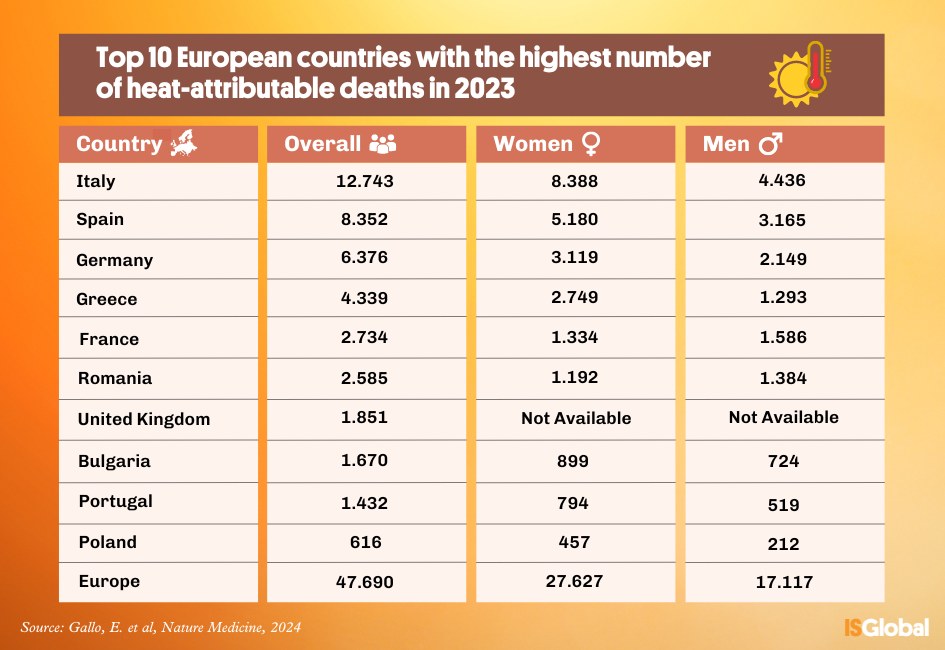London, August 12, 2024, (Oilandgaspress) ––More than 47,000 people died in Europe as a result of high temperatures in 2023, the warmest year on record globally and the second warmest in Europe. This is the estimate of a study led by the Barcelona Institute for Global Health (ISGlobal), a centre supported by the “la Caixa” Foundation, and published in Nature Medicine. The researchers report that the vulnerability to heat of European societies has progressively decreased over the present century, and estimate that without these societal adaptation processes, the heat related mortality burden over the past year would have been 80% higher.
The study replicates the methodology used last year in another paper published in Nature Medicine, which estimated that heat caused more than 60,000 deaths during the summer of 2022, which represented the highest heat related mortality burden of the last decade. In a nutshell, researchers used temperature and mortality records from 823 regions in 35 European countries for the period 2015-2019 to fit epidemiological models to estimate heat related mortality in each European region over the entire year 2023.
In contrast to the summer of 2022, which was characterised by persistent extreme temperatures in the central part of the season from mid-July to mid-August, no large thermal anomalies were recorded during the same weeks in 2023. However, two episodes of high temperatures in mid-July and late August would have accounted for more than 57% of the overall estimated mortality, with more than 27,000 deaths.
Higher vulnerability for women and people over 80 years
In line with previous studies, the data show a higher vulnerability of women and older people. Specifically, after accounting for the population, the heat related mortality rate was 55% higher in women than in men, and 768% higher in people over 80 years of age than in people aged between 65 and 79 years.
Possible underestimation of the actual heat related mortality burden
The authors of the study caution that these numbers may underestimate the actual heat related mortality burden. Due to the unavailability of daily, homogeneous mortality records during the year of 2023, they had to use weekly counts of deaths from Eurostat. In a recent study published in the Lancet Regional Health – Europe, the same authors showed that the use of weekly data would lead to an underestimation of the heat related mortality burden, and described a methodology to correct this bias. Taking this into account, researchers estimate that the likely heat related death toll in 2023 could have actually been of the order of 58,000 deaths in the 35 countries studied, although a more accurate estimate could only be obtained if improved mortality databases were made available to the scientific community.
Societal adaptation to heat prevents up to 80% of mortality
One of the aims of the study was to assess whether there has been a decrease of the vulnerability to heat in Europe, a process that is generally understood as an adaptation to rising temperatures. To do this, the researchers fitted the same type of model to temperature and mortality data from the periods 2000-2004, 2005-2009, 2010-2014 and 2015-2019. They then plugged 2023 temperatures and mortality numbers into each of the four models to estimate the number of deaths that would have occurred in each period if temperatures had been as high as they had been in 2023.
Using this method, it was estimated that if the temperatures recorded in 2023 had occurred in the period 2000-2004, the estimated heat related mortality would have exceeded the number of 85,000 deaths, that is, 80% higher than the result arising from the vulnerability to heat in the period 2015-2019. For people over 80 years, the number of deaths would have more than doubled, from 1,102 to more than 2,200 heat related deaths.

Information Source: Read More
Oil and gas press covers, Energy Monitor, Climate, Renewable, Wind, Biomass, Sustainability, Oil Price, LPG, Solar, Marine, Aviation, Fuel, Hydrogen, Electric ,EV, Gas,




